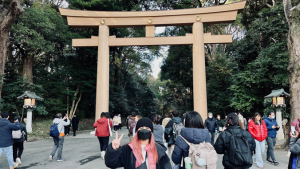
In an immersive experience to discover architecture from a new perspective, students at the University of Hawaiʻi at Mānoa School of Architecture participated in an international design exchange program for one week in Japan, collaborating with architecture students from the Nagaoka Institute of Design in February.
Twelve UH undergraduate students, ranging from first-year to fourth-year, enrolled in the course ARCH 436 Design Exchange this spring, which included a trip to Japan. Students traveled to Tokyo and Nagaoka, and spent time touring peace memorials, and attending design lectures and workshops at the Nagaoka Institute of Design.
“I have never left the country until this trip to Japan and that opportunity alone was such an incredible opportunity for me,” said Byrne Williams, a first-year architecture student. “I had so much fun communicating with the Japanese students, visiting historical sites and learning more about historical events like World War II through the eyes of people in Japan. Even through those hard days working all day long trying to make a deadline, I enjoyed every second of it.”
UH students had the opportunity to travel abroad beyond guided tours or site visits. They also designed and collaborated with students from Japan while experiencing a foreign environment, culture, language and climate.
“This opportunity was important for my educational journey because the subject matter of the peace memorial presents unique and sensitive issues for students to consider when designing,” said Sophia Collela, a second-year architecture student. “This is especially important when working in a foreign place where one is not familiar with the collective perspective of the people in said place. What I learned here parallels what designers in Hawaiʻi face when we aim to evoke cultural identity appropriately in a space.”
Shared experiences
 Honolulu and Nagaoka share a bond of war experience. Like many other places that have endured war, each has undergone healing, recovery and reconstruction. Students and faculty at both institutions shared a renewed commitment to peace and friendship, embodied by this effort.
Honolulu and Nagaoka share a bond of war experience. Like many other places that have endured war, each has undergone healing, recovery and reconstruction. Students and faculty at both institutions shared a renewed commitment to peace and friendship, embodied by this effort.
“Students develop new ways of communicating, collaborating and negotiating,” said Karla Sierralta, associate professor in the School of Architecture. “They are also exposed to new ways of seeing and making. I hope this experience ignites their curiosity and desire to learn more about architecture and design in other cultures, and contributes to defining their own identities as designers.”
In March, students from the Nagaoka Institute of Design will spend a week in Honolulu collaborating with UH architecture students and observing design and architecture in Hawaiʻi.
“These academic and cultural exchanges deepen understanding and encourage collaboration and empathy for others, celebrating and reinforcing the diversity in our communities,” said Sierralta.


